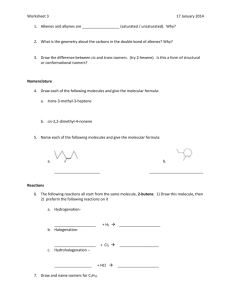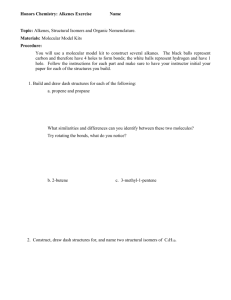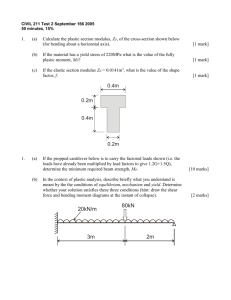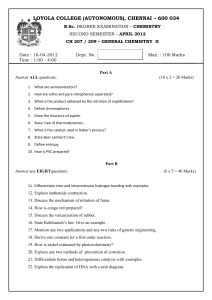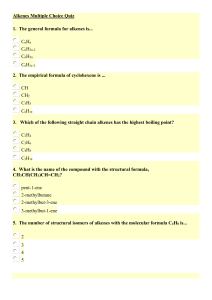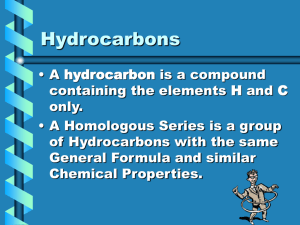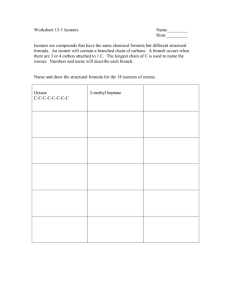AS Chemistry 4_1_3 Alkenes
advertisement
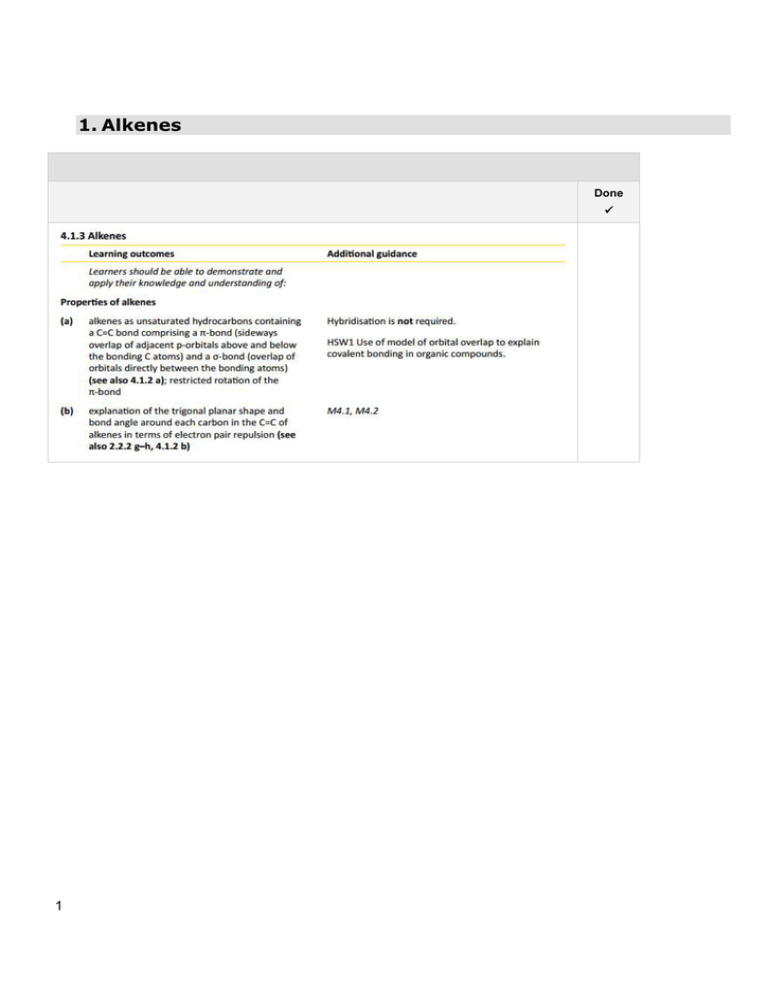
1. Alkenes Done 1 Revision notes 2 Past paper questions In this question, one mark is available for the quality of use and organisation of scientific terms. Describe, with the aid of a suitable diagram, the formation of the -bond in propene. State the shape, and an approximate value for the bond angles, around each carbon atom in propene. Describe, with the aid of a suitable example, why some alkenes show E/Z isomers, including cis-trans isomerism. ………………………………………………………………………………………………..... ………………………………………………………………………………………………..... ………………………………………………………………………………………………..... ………………………………………………………………………………………………..... ………………………………………………………………………………………………..... ………………………………………………………………………………………………..... ………………………………………………………………………………………………..... ………………………………………………………………………………………………..... ………………………………………………………………………………………………..... ………………………………………………………………………………………………..... ………………………………………………………………………………………………..... ………………………………………………………………………………………………..... ………………………………………………………………………………………………..... ………………………………………………………………………………………………..... ………………………………………………………………………………………………..... ………………………………………………………………………………………………..... ………………………………………………………………………………………………..... ………………………………………………………………………………………………..... [9] Quality of Written Communication [1] [Total 10 marks] 3 Examiner’s comments This was very poorly answered. Diagrams of the -bond were generally incorrect. Most stated a bond angle but many failed to state the shapes. Many didn’t appreciate, or forgot, that the shape and bond angles in the methyl group were different from the shape and bond angles of the other two carbons. The explanation of cis-trans isomerism was generally well answered. The mark for quality of written communication proved to be difficult to attain. The quality of expression and written communication often hindered the scoring of the chemistry marks. 4 2. Stereoisomerism Done Key areas to concentrate on… You need to know: what E/Z isomerism means and how it differs from cis-trans isomerism. OCR have produced a PowerPoint presentation on CIP priority rules which can be found by clicking here: http://www.ocr.org.uk/Images/208571-cip-rules-activity-presentationlesson-element.ppt 5 Revision notes 6 CIP Rules Activity http://www.ocr.org.uk/Images/208571-cip-rules-activity-presentation-lesson-element.ppt Stereoisomerism in alkenes (c) (i) explanation of the terms: stereoisomers (compounds with the same structural formula but with a different arrangement in space) E/Z isomerism (an example of stereoisomerism, in terms of restricted rotation about a double bond and the requirement for two different groups to be attached to each carbon atom of the C=C group) cis–trans isomerism (a special case of E/Z isomerism in which two of the substituent groups attached to each carbon atom of the C=C group are the same) (ii) use of Cahn–Ingold–Prelog (CIP) priority rules to identify the E and Z stereoisomers (d) determination of possible E/Z or cis–trans stereoisomers of an organic molecule, given its structural formula Task 1 Reviewing structural isomerism and using models to understand stereoisomerism. 1. Using molecular models (or computer modelling software), make models of butane C4H10 and its isomer. These isomers are structural isomers – the atoms are arranged differently. Butane 7 Isomer 2. Now make models of dichloroethene C2H2Cl2 and its isomers. You should get 3 isomers, the first one is done for you. 1,1 dichloroethene 3. What property does the double bond have that can allow stereoisomerism to happen in 1,2 dichloroethene? Your model should show this. The names are coded. If the methyl groups are on the same side the full name is (Z)1,2 dichloroethene, if the methyl groups are on opposite sides, the name is (E)1,2 dichloroethene. The letters derive from German, Z stands for zusammen (together), while E stands for entgegen (opposite). If two of the groups are the same, we also use the terms cis and trans to describe the two isomers. 8 Task 2 Test 1 1. Which of these alkenes shows stereoisomerism? a. H2C=CBr2 b. CH3CH=CHCH3 c. CH3CH=C(CH3)2 d. CHBr=CHBr e. CHCl=CH2 2. What simple rule enables us to decide if an alkene does not show stereoisomerism? 9 3. Draw diagrams to show the E and Z isomers of those alkenes that do show stereoisomerism E Z Task 3 Formative Assessment How well did you do? I understand what structural isomers are and can show this by drawing diagrams I understand the difference between structural isomers and stereoisomers I can draw diagrams to show stereoisomers I can name isomers as cis, trans, E or Z 10 I can do this I struggled I am lost Task 4 Cahn, Ingold, Prelog (CIP) Rules Not all alkenes are as simple as 1,2 dichloroethene. Make a models of the two stereoisomers of 1-bromo 2chloro 2-iodoethene and draw the structures of them. Deciding on letters for the isomers is harder because there are four different atoms round the double bond. We cannot use the labels cis and trans. Cahn, Ingold and Prelog devised some rules to enable the naming. E/Z descriptors are assigned by using a system for ranking priority of the groups attached to each stereocentre. This procedure, often known as the sequence rules, is the heart of the CIP system. 1. Compare the atomic number (Z) of the atoms directly attached to the stereocentre (double bond); the group having the atom of higher atomic number receives higher priority. 2. If there is a tie, we must consider the atoms at distance 2 from the stereocentre—as a list is made for each group of the atoms bonded to the one directly attached to the stereocentre. Each list is arranged in order of decreasing atomic number. Then the lists are compared atom by atom; at the earliest difference, the group containing the atom of higher atomic number receives higher priority. 3. If there is still a tie, each atom in each of the two lists is replaced with a sub-list of the other atoms bonded to it (at distance 3 from the stereocentre), the sub-lists are arranged in decreasing order of atomic number, and the entire structure is again compared atom by atom. This process is repeated, each time with atoms one bond farther from the stereocentre, until the tie is broken. It is the placing of the two highest priority substituents with respect to the double bond which matters. If both high priority substituents are on the same side of the double bond, i.e. in the cis configuration, then the stereoisomer is assigned a Z or Zusammen configuration. If, by contrast they are in a trans configuration, then the stereoisomer is assigned an E or Entgegen configuration. In summary – the two atoms with greatest atomic mass will be the ones to determine whether the stereoisomer is E or Z. If chains of carbon atoms are involved, the 2 longest chains at opposite ends of the double bond will determine the labelling of the stereoisomer. 11 Decide on the order of priority for the 4 atoms round the double bond in1-bromo 2-chloro 2-iodoethene. Priority Atom 1 2 3 4 Now you should be able to name the 2 stereoisomers. Insert the names into the boxes below: 12 Task 5 Test 2 Now decide whether the compounds below show stereoisomerism, and draw structures of any E/Z isomers. E 3-chloro-oct-3-ene 3-methylhept-3-ene 2 chloro, 3 ethylhex-2-ene 13 Z Task 6 Formative Assessment How well did you do? I can draw diagrams to show the difference between more complex stereoisomers. I can use atomic masses to decide on the priorities of groups I can use the location of the two highest priority groups to assign E and Z labels 14 I can do this I struggled I am lost Past paper questions But-1-ene is just one isomer with the molecular formula C4H8. Using C4H8 as your example, describe and explain what is meant by structural isomerism and cis-trans isomerism. Include diagrams in your answer. In your answer you should make clear how each type of isomerism is related to structural features. ………………………………………………………………………………………………..... ………………………………………………………………………………………………..... ………………………………………………………………………………………………..... ………………………………………………………………………………………………..... ………………………………………………………………………………………………..... ………………………………………………………………………………………………..... ………………………………………………………………………………………………..... ………………………………………………………………………………………………..... ………………………………………………………………………………………………..... ………………………………………………………………………………………………..... ………………………………………………………………………………………………..... ………………………………………………………………………………………………..... ………………………………………………………………………………………………..... ………………………………………………………………………………………………..... ………………………………………………………………………………………………..... ………………………………………………………………………………………………..... ………………………………………………………………………………………………..... ………………………………………………………………………………………………..... ………………………………………………………………………………………………..... ………………………………………………………………………………………………..... [Total 7 marks] 15 3. Reactions of alkenes Module 1 - Basic concepts and hydrocarbons Alkenes Done Key areas to concentrate on… You need to learn the general equation and typical conditions for each of the four main alkene reactions: with hydrogen with halogens 16 Past paper questions Cyclohexene can be converted into cyclohexane. cyclohexene cyclohexane Suggest suitable reagents and conditions for this reaction. reagents .............................................................................................................. conditions ............................................................................................................ [Total 2 marks] Examiner’s comments This was generally well answered but it tended to be two or nothing. 17 4. Further addition reactions of alkenes Module 1 - Basic concepts and hydrocarbons Alkenes Done Key areas to concentrate on… You need to learn the general equation and typical conditions for each of the four main alkene reactions: with halogens with steam with hydrogen with hydrogen halides You should learn: what electrophilic addition is, and make sure you can describe this mechanism by use of diagrams and curly arrows; and addition polymerisation, another key feature of alkenes. You need to be able to define the term: electrophile 18 Revision notes 19 Revision notes 20 Past paper questions Alkenes undergo electrophilic addition reactions to form saturated compounds. (i) Define the term electrophile. .................................................................................................................... [1] Past paper questions Propene, CH3CH=CH2 reacts with HBr to produce two bromoalkanes that are structural isomers. CH3CHBrCH3 CH3CH CH2 + HBr CH3CH2CH2Br Propyne, CH3CCH, reacts like propene. It reacts with HBr to give three isomers with molecular formula C3H6Br2. Draw the three isomers with molecular formula C3H6Br2. [Total 3 marks] Examiner’s comments Many simply drew any isomers of C3H6Br2 and often repeated 1,3-dibromopropane. Two marks out of three were very common. 21 [ Revision notes 22 Past paper questions Isoprene is an alkene that can be tapped from some trees. It is the monomer in natural rubber. Limonene is a natural oil found in the rind of oranges and lemons. Both isoprene and limonene contain two double bonds. Their structural and skeletal formulae are shown below. CH3 C CH H2C CH2 H2C HC CH2 CH C H3C CH2 H3C isoprene (a) (i) CH2 limonene What is the molecular formula of isoprene? .......................................... [1] (ii) What is the empirical formula of limonene? .......................................... [1] (b) In the presence of a suitable catalyst, isoprene and limonene both react with hydrogen. (i) State a suitable catalyst for this reaction. ............................................... [1] (ii) Write an equation for the reaction when isoprene reacts completely with hydrogen. [2] 23 Past paper questions (cont.) (iii) Draw the skeletal formula of a product formed when limonene reacts partially with hydrogen. [1] (c) 2-Methylbut-1-ene can be formed by the partial hydrogenation of isoprene. 2-Methylbut-1-ene reacts with Br2 to produce 1,2-dibromo-2-methylbutane by an electrophilic addition mechanism. The mechanism for the reaction is shown below. H3C CH3 H3C C CH2 step 1 CH3CH2 CH2Br C CH3CH2 Br step 2 CH3CH2 C CH2Br Br Br Br (i) In step 1, Br2 behaves as an electrophile. Explain what is meant by the term electrophile. .................................................................................................................... [1] (ii) Label any relevant dipoles and add ‘curly arrows’ to the mechanism to show the movement of electron pairs in step 1 and in step 2. [3] [Total 10 marks] Examiner’s comments 24 (a) This was generally very well answered with many scoring both marks. It was unfortunate that a ‘C’ was not shown in the structural formula of isoprene but the Examiners compensated candidates by crediting both C5H8 and C4H8. (b) Most scored the mark in (i) but very many failed to score both marks in (ii). It was common to see equations for partial hydrogenation. Candidates who had misinterpreted the structural formula of isoprene in (a)(i) were also given credit in this section. The partial hydrogenation of limonene was reasonably well done but it was not uncommon to see isoprene rather than limonene. A surprising number indicated an extra C by drawing structures that revealed a misunderstanding of skeletal formulae such as those shown below. or (c) (i) (ii) 25 This was surprisingly badly answered with very many not scoring the mark. As always the response to the mechanism was very Centre-specific and it was often three marks or none. It is important that Centres look carefully at the mark schemes to see what is required to score the marks. Revision notes 26 27 6. Polymers from alkenes Done Revision notes 28 Past paper questions But-1-ene can undergo polymerisation. Draw a section of the polymer that can be formed from but-1-ene. Show two repeat units. [Total 2 marks] Past paper questions Polymer A, shown below, can be formed from an alkene. C2H5 H C2H5 H C2H5 H C2H5 H C C C C C C C C H H H H H H H H A polymer A (i) State the type of polymerisation involved in the formation of polymer A. .................................................................................................................... [1] (ii) Draw a circle around the repeat unit of polymer A. [1] (iii) Identify the monomer that formed polymer A. [1] (iv) Name polymer A. .................................................................................................................... [1] [Total 4 marks] 29 7. Waste polymers and alternatives Done Revision notes 30 ● We produce over three million tonnes of plastic each year ● Households are the biggest producers of plastic waste ● 60 % of household waste comes from packaging ● More than 80 % of this plastic is used once and then goes to landfill sites ● Only 7 % of plastic is recycled. In addition to household waste, there is also the issue of plastic litter (mainly packaging) which is discarded in the environment. On land it is ugly but in the sea it can be deadly – it can cause injury and death to birds, fish and other sea creatures. Given all this, it is not surprising that people are concerned about plastic waste and are increasingly looking to scientists to produce a degradable plastic to help solve the problem. However, there is much debate among scientists and environmentalists as to whether degradable or nondegradable plastic is better for the environment. The conclusions drawn by researchers studying this topic are not always what you might expect. To understand fully the effect a product has on the environment it is necessary to carry out a ‘life cycle analysis,’ which means looking at the impacts of production, use and disposal of the product. There are two kinds of degradable plastic: photodegradable and biodegradable. Photodegradable plastic is usually made of oil-based polymers, just like ordinary plastic. It either has bonds in its structure that can be weakened and broken by sunlight, or it contains a chemical additive which absorbs light and then attacks the polymer and breaks some of the bonds. Once a photodegradable plastic is exposed to light it begins to break down – whether you want it to or not. This can be disastrous if it is mixed in with other plastics during recycling. Photodegradable plastics tend to break down into small particles of plastic rather than decomposing completely. The idea is that these small pieces will then biodegrade. Unfortunately, they are often not biodegradable and so remain in the environment. The effect that a build-up of small pieces of plastic in the soil might have on the environment has not been investigated. At present, most plastic waste ends up in a landfill site where it is buried in a dark hole in the ground. Under these conditions, photodegradation cannot take place. Biodegradable plastics can be made from oil or from plant-based products. They are attacked by bacteria, fungi or other micro-organisms which use them as food. The most commonly used plastics have been tested to find out whether they are biodegradable. Polythene is biodegradable as long as its chains have a molecular weight of less than 500; most other polymers are not. Polyesters are susceptible to biodegradation but they are used very little in packaging materials. As the majority of plastic waste is from packaging, using polyesters will not really help solve either the problem of the large quantity of waste produced or that of litter in the environment. There is a lot of interest in the idea of making a plastic that can biodegrade in a landfill site. Unfortunately, once a landfill is covered with soil, there is limited oxygen and water available (the conditions are said to be ‘anaerobic’) and the rate of degradation of all materials (even those that biodegrade rapidly on the surface) becomes extremely slow. Discarded food has been found in landfill sites several years after it was thrown away. With this in mind, the British Plastics Federation (a trade association of plastics manufacturers) opposes degradable plastics on the grounds that plastic waste is best recycled. The environmental pressure group ‘Friends of the Earth’ agrees, arguing that degradable plastic does nothing to promote lasting solutions to plastic waste and that we should be aiming to reduce the amount of plastic we use in the first place and reuse or recycle what we do use. http://www.rsc.org/Education/Teachers/Resources/Inspirational/resources/6.1.2.pdf Further reading: http://www.guardian.co.uk/supermarkets/story/0,12784,1274047,00.html is a newspaper story on degradable bags. 31 [ 32 Past paper questions But-1-ene is just one isomer with the molecular formula C4H8. The chemical properties of but-1-ene are similar to those of ethene. • Using this information, predict the organic products in, and the equations for, the reactions of but-1-ene with bromine, hydrogen bromide and steam. • Draw a section of the polymer formed from but-2-ene by showing two repeat units. • Discuss two ways in which chemists are trying to minimise the damage to the environment caused by the disposal of polymers. ………………………………………………………………………………………………..... ………………………………………………………………………………………………..... ………………………………………………………………………………………………..... ………………………………………………………………………………………………..... ………………………………………………………………………………………………..... ………………………………………………………………………………………………..... ………………………………………………………………………………………………..... ………………………………………………………………………………………………..... ………………………………………………………………………………………………..... ………………………………………………………………………………………………..... ………………………………………………………………………………………………..... ………………………………………………………………………………………………..... ………………………………………………………………………………………………..... ………………………………………………………………………………………………..... ………………………………………………………………………………………………..... ………………………………………………………………………………………………..... ………………………………………………………………………………………………..... [Total 10 marks] 33 Past paper questions In this question, one mark is available for the quality of use and organisation of scientific terms. Alkenes are used in the industrial production of many organic compounds. Outline how alkenes are used in the manufacture of margarine, polymers such as poly(propene). State any essential conditions. Write a balanced equation for the manufacture of poly(propene) and draw a section of the polymer to show two repeat units. State two difficulties in the disposal of polymers like poly(propene). Suggest two ways in which waste polymers may be treated in the future. [9] Quality of Written Communication [1] [Total 10 marks] ………………………………………………………………………………………………..... ………………………………………………………………………………………………..... ………………………………………………………………………………………………..... ………………………………………………………………………………………………..... ………………………………………………………………………………………………..... ………………………………………………………………………………………………..... ………………………………………………………………………………………………..... ………………………………………………………………………………………………..... ………………………………………………………………………………………………..... ………………………………………………………………………………………………..... ………………………………………………………………………………………………..... ………………………………………………………………………………………………..... ………………………………………………………………………………………………..... ………………………………………………………………………………………………..... ………………………………………………………………………………………………..... 34 ………………………………………………………………………………………………..... ………………………………………………………………………………………………..... ………………………………………………………………………………………………..... ………………………………………………………………………………………………..... ………………………………………………………………………………………………..... ………………………………………………………………………………………………..... ………………………………………………………………………………………………..... ………………………………………………………………………………………………..... ………………………………………………………………………………………………..... ………………………………………………………………………………………………..... ………………………………………………………………………………………………..... ………………………………………………………………………………………………..... ………………………………………………………………………………………………..... ………………………………………………………………………………………………..... ………………………………………………………………………………………………..... ………………………………………………………………………………………………..... ………………………………………………………………………………………………..... ………………………………………………………………………………………………..... ………………………………………………………………………………………………..... Examiner’s comments This part was taken directly from the specification but was very poorly answered and it appeared to be unfamiliar to very many students. Very many lost marks by not reading the question carefully. Marks were lost by failing to write a balanced equation for the polymerisation of propene and for not showing a section of the polymer containing two repeat units. Almost all candidates scored the two marks allocated for the problems in disposal of polymers and many wrote at length about how polymers may be processed in the future. 35
